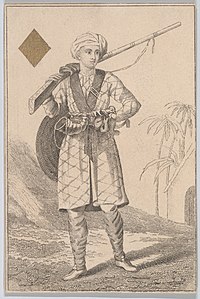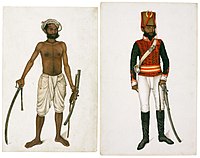Sepoy
This article needs additional citations for verification. (November 2020) |
| Sepoy | |
|---|---|
 Hyder Ali as a sepoy | |
| Active | 16th to 21st centuries |
| Country | Mughal Empire India Pakistan Nepal |
| Branch | infantry and artillery |
| Equipment | Musket |
Equivalent ranks of Indian military
| ||
|---|---|---|
| Indian Navy | Indian Army | Indian Air Force |
Commissioned ranks
| ||
| Admiral of the fleet |
Field marshal | Marshal of the Indian Air Force |
| Admiral | General | Air chief marshal
|
Vice admiral |
Lieutenant general |
Air marshal
|
| Rear admiral | Major general | Air vice marshal |
| Commodore | Brigadier | Air commodore |
| Captain | Colonel | Group captain |
| Commander | Lieutenant colonel | Wing commander
|
| Lieutenant commander | Major | Squadron leader |
| Lieutenant | Captain | Flight lieutenant |
Sub lieutenant |
Lieutenant | Flying officer |
Junior commissioned ranks
| ||
Master chief petty officer 1st class |
Subedar major[Alt 1] |
Master warrant officer
|
Master chief petty officer 2nd class |
Subedar[Alt 2] | Warrant officer |
Chief petty officer |
Naib subedar[Alt 3] |
Junior warrant officer
|
Non-commissioned ranks
| ||
| Petty officer | Havildar | Sergeant |
| Leading seaman | Naik | Corporal |
| Seaman 1 | Lance naik | Leading aircraftsman
|
| Seaman 2 | Sepoy | Aircraftsman
|
Footnotes
| ||
Sepoy (
In the 18th century, the
The term "sipahi" or sometimes "sepoy" continues in use in the modern
Etymology
In Persian اسپ (Aspa) means horse and Ispahai is also the word for cavalrymen.
The term sepoy is derived from the Persian word sepāhī (سپاهی) meaning the traditional "infantry soldier" in the Mughal Empire.
In the Ottoman Empire the term sipahi was used to refer to cavalrymen.[3]
Historical usage
The term sepoy came into common use in the forces of the British East India Company in the eighteenth century, where it was one of a number of names, such as peons, gentoos, mestees and topasses, used for various categories of native soldier. Initially it referred to Hindu or Muslim soldiers without regular uniforms or discipline. It later generically referred to all native soldiers in the service of the European powers in India.[3] Close to ninety-six percent of the British East India Company's army of 300,000 men were native to India and these sepoys played a crucial role in securing the subcontinent for the company.[4]
Equipment
The earliest sepoys used matchlock muskets and operated bulky and inefficient cannons to a limited extent during the reigns of Babur Akbar when archery and fighting from horseback was more common. By the time of Aurangzeb the Mughal armies had advanced significantly and utilized a wider range of weapons to win battles.
During the
History
Mughal Empire 16th–18th centuries
-
A Mughal sepoy, under the command of Mirza Najaf Khan.
-
TheMughal Emperor Aurangzebleads his final expedition (1705), (sepoy column visible in the lower right).
A Sipahi or a sepoy was an infantryman armed with a musket in the army of the Mughal Empire.
The earliest sepoys were armed with daggers,
By the 18th century individual Nawabs employed their own sepoy units as did the European merchant companies established in parts of India.
Sepoys became more visible when they gained European arms and fought for various fragmented polities of the Mughal Empire during the
Sepoys in British service
-
Kala, the Sepoy, with Saber Drawn and in Uniform. Two miniatures from the Fraser Album. Delhi, 1815–1816. The David Collection
-
Sepoy of the Indian infantry, circa 1900.
-
An early 20th century sepoy in the Indian Army, wearing a kurta.
The
The salary of the sepoys employed by the East India Company, while not substantially greater than that paid by the rulers of Indian states, was usually paid regularly. Advances could be given and family allotments from pay due were permitted when the troops served abroad. There was a commissariat and regular rations were provided. Weapons, clothing and ammunition were provided centrally, in contrast to the soldiers of local kings whose pay was often in arrears. In addition local rulers usually expected their sepoys to arm themselves and to sustain themselves through plunder.[3]
This combination of factors led to the development of a sense of shared honour and ethos amongst the well drilled and disciplined Indian soldiery who formed the key to the success of European feats of arms in India and abroad.[3]
Following the Indian Rebellion of 1857 the surviving East India Company regiments were merged into a new Indian Army under the direct control of the British Crown. The designation of "sepoy" was retained for Indian soldiers below the rank of lance naik, except in cavalry where the equivalent ranks were sowar or "trooper".
| Presidency | Salary In Rupees (1760s) |
|---|---|
| Bengal | 6[8] |
| Bombay | 7[8] |
| Madras | 7[8] |
Sepoys in French service
Following the formation of the
It is to the military genius of the French that we are indebted for the formation of the Indian army. Our warlike neighbours were the first to introduce into India the system of drilling native troops and converting them into a regularly disciplined force. Their example was copied by us, and the result is what we now behold.
— Sir Justin Sheil (1803–1871).[11]
Sepoys in Portuguese service
Sepoys were also recruited in Portuguese India. The term cipaio (sepoy) was also applied by the Portuguese to African soldiers in Angola, Mozambique and Portuguese Guinea, plus African rural police officers. Cipaios from Angola provided part of the garrison of Goa during the final years of Portuguese rule of that Indian territory.
Contemporary sepoys
The title of "sepoy" is still retained in the modern
Other usages
The same Persian word reached English via another route in the forms of sipahi and spahi. Zipaio, the Basque version of the word, is used by leftist Basque nationalists as an insult for members of the Basque Police,[13] implying that they are not a national police of the Basque region due to their connection with the Spanish government.
In Hispanic American countries, especially in Argentina, the word cipayo has historically been used as a pejorative colloquial expression referring to individuals considered as serving foreign interests, as opposed to serving their own country.[14]
See also
- Indian Rebellion of 1857 (termed by some The Sepoy Mutiny)
- Maharajah and the Sepoys
- Jawan, a contemporary soldier of the armies of India and Pakistan.
- Sowar, meaning "the one who rides" in Persian, was originally a rank during the Mughal period.
- Lascar, Indian sailors in European service
- Askari, African troops in service to colonial powers similar to the Sepoys.
- Sepah, the Islamic Revolutionary Guard Corpsof Iran
References
- S2CID 159458449.
- ^ Presidency armies
- ^ ISBN 0-03-012911-7.
- ^ "India's Sepoy Mutiny". Fsmitha.com. Retrieved 24 September 2013.
- ISBN 1-85532-344-3.
- ISBN 1-85532-344-3.
- ISBN 0-333-41837-9.
- ^ a b c "Pay, Allowances and Pension" (PDF).
- ISBN 1-85532-709-0
- ISBN 2-7025-0142-7, pp. 50–51
- ^ Glimpses of Life and Manners in Persia by Lady Mary Leonora Woulfe Sheil, with additional notes by Sir Justin Sheil [1]
- ISBN 0-333-17236-1, pp. 312, 545.
- ^ La AN condena a dos años de cárcel al autor de los destrozos en el "bosque de Oma"[permanent dead link], Deia, 12 January 2005. Quoting a sentence from the Audiencia Nacional: «siendo público y notorio que el término "zipaio" es el que se da a los miembros de la Policía» vasca.
- ^ Qué significan cipayo, gorila fondos bruite y otras palabras que todos repiten y pocos conocen. Apertura.com





